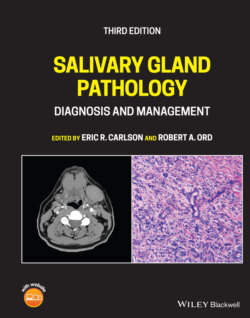Читать книгу Salivary Gland Pathology - Группа авторов - Страница 85
VASCULAR LESIONS Lymphangioma (Cystic Hygroma)
ОглавлениеThe cystic hygroma is included in this discussion because of its transpatial location and that it might mimic other cystic masses. It is typically multilocular and has an epicenter in the posterior triangle, but may be found in the submandibular space and less commonly in the sublingual space. The imaging characteristics are those of cysts and follow fluid density on CT and signal intensity on MRI, although do typically demonstrate internal architecture from septation with varying thickness. CT typically demonstrates isodensity to simple fluid or slight hyperdensity if infected or contains products of hemorrhage (Koeller et al. 1999; Makariou et al. 2003) (Figure 2.47). US demonstrates anechoic spaces consistent with simple fluid with septa of variable thickness. Like cystic (and few solid lesions) lesions, there is increased thru transmission. Infection and hemorrhage cause variable degrees of echogenicity and thicker septations (Koeller et al. 1999; Makariou et al. 2003). MRI, however, can be variable on both T1 and T2 sequences based on the fluid characteristics. With simple fluid, T1 and T2 are isointense to simple fluid (CSF) but with infection, or hemorrhage products, the increased protein concentration as well as cellular debris and iron from hemoglobin can result in varying degrees of T1 hyperintensity and variable hypo‐ or hyperintensity on T2 (Figure 2.48). Any of these modalities may demonstrate fluid‐fluid or fluid‐debris layers. Both CT and MRI will demonstrate enhancement in the setting of infection (Macdonald et al. 2003). These lesions are more common in the pediatric age group, although small lesions may persist into adulthood. When found in the submandibular or sublingual space, they may be mistaken for a ranula (especially giant or plunging ranulae) and less likely hemangioma or thyroglossal duct cyst if midline (Kurabayashi et al. 2000; Macdonald et al. 2003). Although dermoids are in the differential diagnosis, they are usually identified by their imaging characteristics secondary to their contents of fat and dermal elements. Epidermoid cysts may be more difficult to differentiate from cystic hygromas and ranulae because of similar imaging characteristics (Koeller et al. 1999). Because the lymphangiomas have a vasculolymphatic origin, they may be associated with venous anomalies and rarely saccular venous aneurysms (Makariou et al. 2003). Vascular flow signals may be seen with Doppler US. The venous anomalies or aneurysms may be difficult to differentiate from other vascular malformations; however, their association with typical findings of lymphangiomas may assist in diagnosis.
Figure 2.47. Axial contrast‐enhanced CT of the neck at the level of the submandibular glands demonstrating a low‐density structure on the right of approximately fluid density (compare to the CSF in the spinal canal), which is intermediate in density relative to the muscles and subcutaneous fat. A large lymphangioma associated with the right submandibular gland was diagnosed.
Figure 2.48. Coronal STIR MRI of the face of a different patient with a very large lymphangioma with large septations. Note the lymphangioma fluid is brighter than the CSF and there is fat suppression of the subcutaneous fat.
